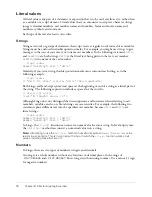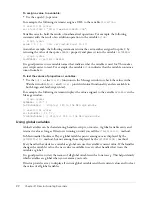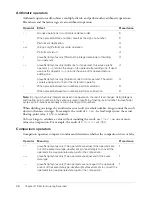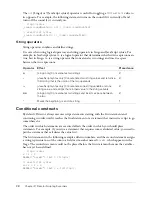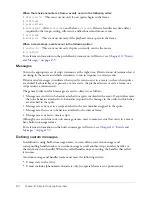
Literal values
19
A decimal number, also called a floating-point number, or float, is any number that includes a
decimal point. In Lingo, the
floatPrecision
property controls the number of decimal places
used to display these numbers. Director always uses the complete number, up to 15 significant
digits, in calculations; Director rounds any number with more than 15 significant digits in
calculations.
JavaScript syntax does not distinguish between integers and floating-point numbers, and merely
uses numbers. For example, the following statements illustrate that the number 1 is an integer in
Lingo and a number in JavaScript syntax, and that the decimal number 1.05 is a float in Lingo
and a number in JavaScript syntax:
-- Lingo syntax
put(ilk(1)) -- #integer
put(ilk(1.05)) -- #float
// JavaScript syntax
trace(typeof(1)) // number
trace(typeof(1.05)) // number
In Lingo, you can convert a decimal to an integer by using the
integer()
function. You can
also convert an integer to a decimal by performing a mathematical operation on the integer, for
example, by multiplying an integer by a decimal. In JavaScript syntax, you can convert a string or
a decimal number to a whole number by using the
parseInt()
function. As opposed to Lingo’s
integer()
function,
parseInt()
rounds down. For example, the following statement rounds
off the decimal number 3.9 and converts it to the integer 4 (Lingo) and the number 3
(JavaScript syntax).
-- Lingo syntax
theNumber = integer(3.9) -- results in a value of 4
// JavaScript syntax
var theNumber = parseInt(3.9); // results in a value of 3
In Lingo, the
value()
function can convert a string into a numerical value.
You can also use exponential notation with decimal numbers: for example, -
1.1234e-100
or
123.4e+9
.
In Lingo, you can convert an integer or string to a decimal number by using the
float()
function. In JavaScript syntax, you can convert a string to a decimal number by using the
parseFloat()
function. For example, the following statement stores the value 3.0000 (Lingo)
and 3 (JavaScript syntax) in the variable
theNumber
.
-- Lingo syntax
theNumber = float(3) -- results in a value of 3.0000
// JavaScript syntax
var theNumber = parseFloat(3) // results in a value of 3
Summary of Contents for DIRECTOR MX 2004-DIRECTOR SCRIPTING
Page 1: ...DIRECTOR MX 2004 Director Scripting Reference...
Page 48: ...48 Chapter 2 Director Scripting Essentials...
Page 100: ...100 Chapter 4 Debugging Scripts in Director...
Page 118: ...118 Chapter 5 Director Core Objects...
Page 594: ...594 Chapter 12 Methods...
Page 684: ...684 Chapter 14 Properties See also DVD...
Page 702: ...702 Chapter 14 Properties See also face vertices vertices flat...
Page 856: ...856 Chapter 14 Properties JavaScript syntax sprite 15 member member 3 4...
Page 1102: ...1102 Chapter 14 Properties...














